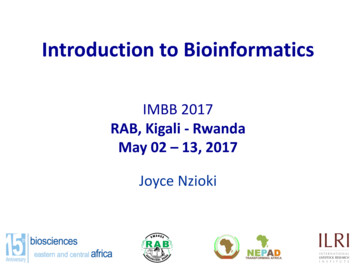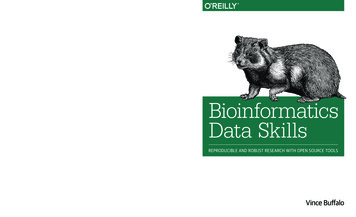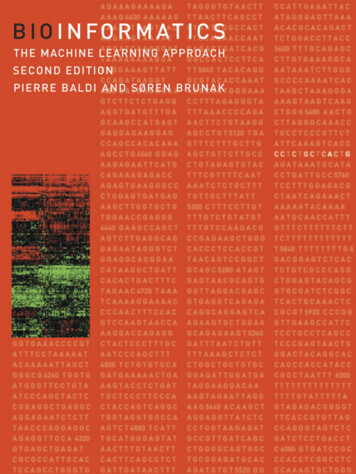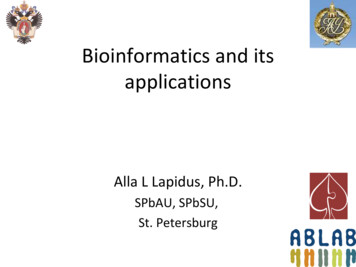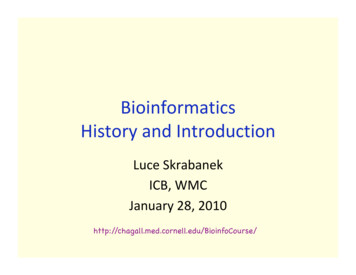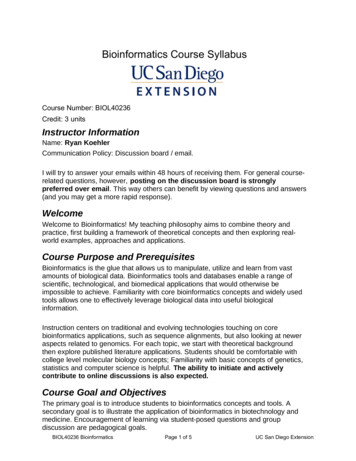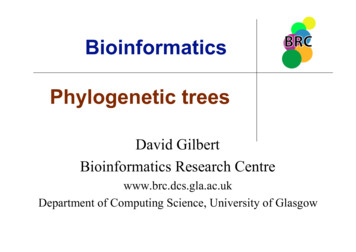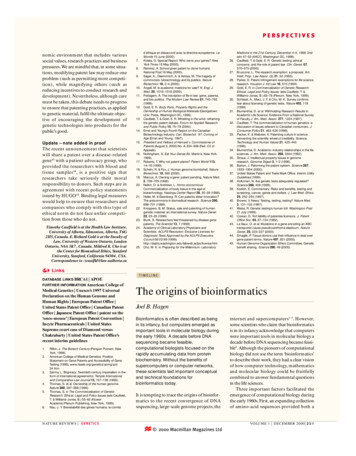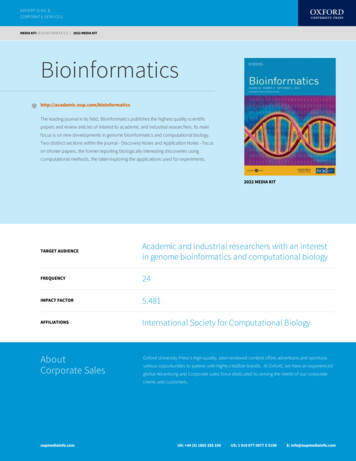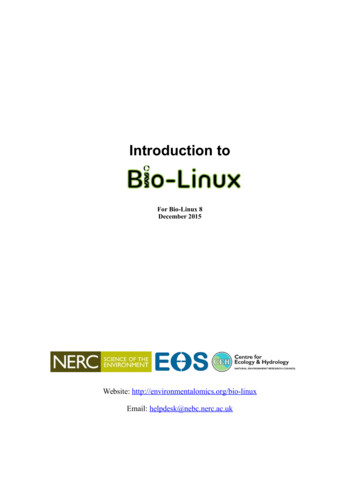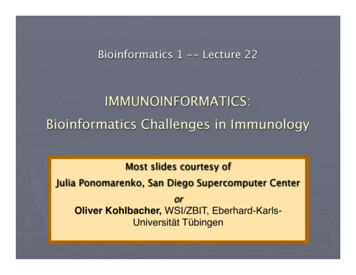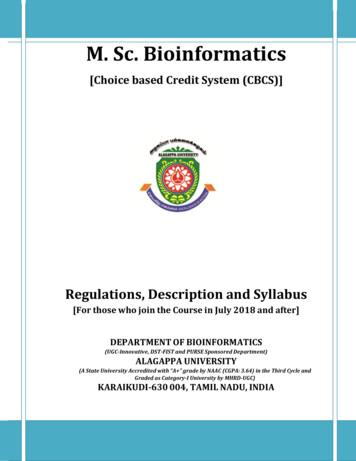
Transcription
M. Sc. Bioinformatics[Choice based Credit System (CBCS)]Regulations, Description and Syllabus[For those who join the Course in July 2018 and after]DEPARTMENT OF BIOINFORMATICS(UGC-Innovative, DST-FIST and PURSE Sponsored Department)ALAGAPPA UNIVERSITY(A State University Accredited with “A ” grade by NAAC (CGPA: 3.64) in the Third Cycle andGraded as Category-I University by MHRD-UGC)KARAIKUDI-630 004, TAMIL NADU, INDIA
ALAGAPPA UNIVERSITY(A State University Accredited with “A ” grade by NAAC (CGPA: 3.64) in the Third Cycle andGraded as Category-I University by MHRD-UGC)M.Sc BIOINFORMATICS(For those who join the Course in July 2018 and after)REGULATIONS AND SYLLABUSREGULATIONS1. EligibilityCandidates for admission to Master of Science in Bioinformatics shall be required tohave passed B.Sc., (Bioinformatics/ Biotechnology/ Microbiology/ Biochemistry/Botany/ Zoology/ Physics/ Chemistry) / B.Sc. (Agri.) / B.V.Sc., BBS or any other course equivalent theretoand must have obtained 55% marks at graduation level.2. Duration of the CourseThe course shall extend over a period of two years under Semester Patternaccounting to four semesters.3. Standards of Passing and award of Division.a) The minimum marks for passing in each theory / lab course shall be 50% of themarks prescribed for the paper / lab.b) A candidate who secures 50% or more marks but less than 60% of the aggregatemarks prescribed for four semesters taken together, shall be awarded SECOND CLASS.c) A candidates who secures 60% or more of the aggregate marks prescribed for foursemesters taken together, shall be awarded FIRST CLASS.d) The practical / project shall be assessed by the two examiners, appointed by theUniversity.4. Number of candidates to be admittedThe maximum number of students to be admitted for the Master’s Programme in anacademic is up to 20.1
5. AdmissionAdmission shall be based on merit basis in accordance with the number of applicationsreceived / entrance examination conducted on the following criteria:i)Entrance Examination Question Paper shall be in the following patterna)No. of Questions to be covered from Physical/Life Sciences at 2 : 50levelb)(compulsory)No of Questions to be covered from Physical Sciences at Degree : 25levelc)(compulsory)No of Questions to be covered from Life Sciences at Degree level: 25 (optional)orNo of Questions to be covered from Mathematics at Degree levelii)A candidate may answer a maximum of 100 questionsiii) Duration of Examination shall be two hoursiv) Tamil Nadu Govt./University norms may be followed for selection6. Examination Question PatternTheory Courses:Max: 75 MarksPart – ATen questions (No choice)(Two questions from each Unit)10 x 2 20 marksPart – BFive questions (either or type)(One question from each Unit)5 x 5 25 marksPart – CThree questions out of fivePractical Viva-voce3 x 10 30 marks7. Grading System of the UniversityMarksGrade PointCGPAGrade96 and above109.51 and above S 91-959.59.01-9.50S86-909.08.51-9.00D 81-858.58.01-8.50D 76-808.07.51-8.00D2DescriptionFirst Class - ExemplaryFirst Class - Distinction
71-757.57.01-7.50A 66-707.06.51-7.00A .50CBelow 5.00RARe-appearAAAbsentBelow 50First ClassSecond Class8. AttendanceThe candidate should have earned attendance of 75% and above during the period forappearing the examination. Candidates who have earned 70% to 74% of attendance haveto apply for condonation in the AU prescribed form with the prescribed fee of Rs.100/per subject and who have earned 60% to 69%, Rs.150/- per subject along with themedical certificate. Candidates who have attended below 60% are not eligible to appearfor the examination.9. Fee structureThe following shall be the fee structure for the M. Sc programme1st YearTuition Fee: Rs. 3000/-Computer, Special and Other Fees : Rs. 7000/2nd YearTuition Fee: Rs. 3000/-Computer, Special and Other Fees : Rs. 6000/-Total Rs. 10,000/-Total Rs. 9,000/-Special and other fees shall be as prescribed by the University10. Objectives of the Programi.To train the students in various Molecular Biology experimental methods that aidsthe students to perform related Structural Biology techniques (Cloning,Expression, Purification & Crystallization) to isolate the protein of interestskillfully through laboratory practical.3
ii.To emphasize on the flexibility of the state of the art technologies availableespecially in the area of Computer Aided Drug Design (CADD) and provide labtraining to know how to manage the generated Biological data.iii.To address the challenges arising from the huge amount of genomic data and toovercome by analyzing and individualizing the corresponding drug responsestowards appropriate drug specified dosages.iv.To create user-friendly tools and databases with the help of programminglanguages and algorithms. Additionally, two journal clubs in a month/ annualnational conference/ weekly career guidance(s) are conducted that would helpthem know about the recent advances in the subject and also develop theirknowledge accordingly.11. Outcomes of the Programi.To work with confidence and conscience in Fundamentals of Biological problemfor instance to identify the structural and functional aspects of small andmacromolecule in a typical biological laboratory and also to be aware ofcontamination issues.ii.To identify suitable leads against targets responsible towards disease onset andprogression that provides a regimen for drug discovery and development proves.Exclusively, at the end of the program the graduates are molded as finercompetent against the thriving competition from the students of premierinstitutes of India.iii.To understand the concepts and specific features of the subject that is furtherperceived as application across the disciplines of Computational and Biosciences.In addition to have established knowledge in scientific writing, on how to give ascientific presentation, how to evaluate a scientific paper, and research ethicsand as well as to apply their learned skills in the techniques within the chosenarea of research.iv.To fulfill needs of the industry for the manpower with the specific skills setsrelated to Bioinformatics.4
S.No12. Choice Based Credit System (CBCS) for those who join in July 2018 or afterCourseName of the CourseCreditMarkCodeInt.Ext.TotalSEMESTER – I1.502101Introduction to 3.502103Mathematics and Statistics for Biologists425751004.502104Molecular Cell Biology and Genetics425751005.502105Lab –I: Programming in C and C 425751006.502501Any one from the Group: Elective –I325751007.502201SEMESTER –IIAlgorithm and Computational Biology425751008.502202Computational Approaches to Phylogeny425751009.502203Molecular Modeling and Drug Design4257510010.502204Lab-II: Molecular Biology and Biochemical techniques4257510011.502205Lab- III: Programming in PERL and MYSQL4257510012.502502Any one from the Group: Elective –II3257510013.502301SEMESTER –IIIPrinciples of Gene Manipulation4257510014.502302Structural Biology4257510015.502303Genomics and Pharmacogenomics4257510016.502304Lab-IV: Computer Aided Drug Design (CADD)4257510017.502305Lab- V: PYTHON Programming and Internet Computing4257510018.502503Any one from the Group: Elective –III32575100Employability Skills219.SEMESTER –IV20.502401Omics and Systems Biology4257510021.502402Lab-VI: Small and Macromolecular Crystallography4257510022.502504Any one from the Group: Elective –IV3257510023.502999Project Reports & Viva-Voce1025751009055016502200Total5
Elective-IA. IPR, Bio-safety and BioethicsB. Fundamentals of ComputingC. General ChemistryElective-IIA. Immunology and ImmunotechnologyB. Data Warehousing and Data MiningC. Database ManagementD. Cell communication and Cell signalingElective-IIIElective-IVA. Nanotechnology and Advanced Drug A. Big data analysis and Next GenerationDelivery SystemSequencingB. BiosensorB. General MicrobiologyC. Molecular InteractionsC. Open Source in BioinformaticsD. Introduction to Neural NetworksD. Biodiversity, Agriculture, Ecosystem,Environment and MedicineOffered by Other DepartmentsDepartmentCourse NameDepartment of Animal Health and ManagementImmunology and ImmunotechnologyDepartment of Nanoscience and TechnologyNanotechnology and Advanced DrugDelivery SystemDepartment of MicrobiologyGeneral MicrobiologyOffered to Other DepartmentsDepartmentCourse NameDepartment of Bioelectronics and BiosensorsDepartment of Animal Health and ManagementDepartment of Nanoscience and TechnologyIntroduction to BioinformaticsDepartment of MicrobiologyAdditional courses to be offered to other departments1. Introduction to Bioinformatics2. Small and Macromolecular CrystallographyCore Subjects3. Computer Aided Drug Design (CADD)4. Genomics and Pharmacogenomics1. Programming in CNon-Major Subjects2. Programming in JavaMOOC’s opted by the DepartmentSubject selection at the time of SWAYAM portal access63 Credits3 Credits3 Credits3 Credits3 Credits3 Credits
REQUIRED FACILITIES FOR THE PROGRAMMEI. For Wet Lab Facility:Basic minor instrumentsFPLC - Protein Purification systemThermocyclerMulti Plate Reader-86 C ultra freezerNano Spectrophotometer-20 C deep freezerKinetic biospectrometerWalk-in cold room storageUpright Polaroid MicroscopeUltra Water PurificationSmall Angle X-ray ScatteringStackable Orbital Shaking Incubator2-D ElectrophoresisUltra centrifugeBiacoreIce flaks makerIsothermal Titration CalorimetryUltra sonicatorNano LC - MS/MSRefrigerated centrifugeSmall and Macromolecule X-ray DiffractometerNext Generation SequencerII. For Computational Lab:IBM Super computerHigh Performance Cluster ComputersHigh Performance Workstations -50Desktop Computers – 50UPS power backupIII. SoftwaresSchrodinger software commercial packageGromacsAmberGaussianCambridge Structural Database7
ALAGAPPA UNIVERSITY, KARAIKUDIDEPARTMENT: BIOINFORMATICSSEMESTER-ICourse DepictionCode: 502101 Introduction to BioinformaticsProgram: M.Sc.,Semester : I (2018-19)Course Title: Introduction toClass Time: 10-1: TuesdayBioinformatics (502101)Name of Course TeacherDr. J. Joseph Sahayarayan &Dr. Sanjeev Kumar SinghMobile: 91 - 9047564087 & 91 - 9894429800Email: bioinformaticsjoseph2015@gmail.com &skysanjeev@gmail.comCourse Brief:The course depicts the fundamental concepts and methods in Bioinformatics, afield at the junction of Biology and Computing. Data intensive, large-scale biologicalproblems are addressed from a computational point of view. The most common problemsare modeling biological processes at the molecular level and making inferences fromcollected data. The course covers the principles and methods used to search and compareDNA, RNA and proteins, cast as biological "sequences". The course explains why they cangive us answers to fundamental biological questions important to fields such as CellBiology, Biochemistry and Medical science. The important public data banks that providedetails of biological systems and components will be discussed. It reviews a wide range oftopics including open resources in bioinformatics, computational sequence analysis,sequence homology searching, gene finding and genome annotation, protein structureanalysis and prediction, genomics, proteomics, phylogenetic analysis, biologicaldatabases, cheminformatics and medical informatics. Protein structures are threedimensional data and the associated problems are structure prediction (secondary andtertiary), analysis of protein structures for clues regarding function, and structuralalignment. It serves a gateway course for all science students.8
Reference/Text Books:Text Books:1. Lesk, A.M. (2014) “Introduction to Bioinformatics”; Oxford University Press, UK,Fourth edition.2. Gretchen Kenney, (2016) "Bioinformatics: Principles and Analysis"; SyrawoodPublishing House USA.Reference Books:1. Scott Markel (2003) “Sequence Analysis in a Nutshell – A Guide to Common Tools &Databases”; O′Reilly; 1 edition, ISBN-13: 978-0596004941.2. David Mount, (2004), “Bioinformatics: Sequence and Genome Analysis”; Cold Spring harborlaboratory Press, US Revised Edition.3. Ole Lund, Nielsen, M., Lundegaard, C. Kesmir, C. and Brnak, S. (2005) “ImmunologicalBioinformatics”; The MIT press.4. Jean‐Michel, Cand Notredame, C. (2006) “Bioinformatics for Dummies”; John Wiley&Sons, Second Edition.5. Kindreas D Batevanis, (2006) “Bioinformatics: A Practical Guide to the Analysis ofGene and Protein”; Wiley Inter Science, Singapore, 3rd Edition.6. Andrew R. Leach & Valerie J. Gillet, (2007) “An Introduction to Chemoinformatics”;Springer, Revised Edition.7. David Edward, (2007) “Plant Bioinformatics”: Methods and Protocol, Humana Press.8. Baxevanis, A.D. and Francis Ouellellette, B.F. (2011) “Bioinformatics –a practical guideto the analysis of Genes and Proteins”; John Wiley & Sons, UK, Third Edition.9. HosseinG.Gilani, KatiaG.Samper, RezaKhodaparastHaghi,(2012)“Chemoinformatics: Advanced Control and Computational Techniques”; AppleAcademic Press, First edition.10. Caroline St Clair, Jonathan E. Visick, (2013) “Exploring Bioinformatics”; Jones andBartlett Publishers, Inc; 2nd Edition, ISBN-13: 978-1284034240.11. Arthur Lesk, (2013) “Introduction to Bioinformatics”; OUP Oxford; 4 Edition, ISBN13: 978-0199651566.9
12. Kayvan Najarian, Siamak Najarian, Shahriar Gharibzadeh, (2017) “Systems Biologyand Bioinformatics: A Computational Approach”; CRC Press; 1 Edition, ISBN-13: 9781138118034.Course Objectives: To make the students:i. To make students understand the essential features of the interdisciplinary field ofscience for better understanding biological data.ii. To provide the student with a strong foundation for performing further research inbioinformatics.iii. To create students opportunity to interact with algorithms, tools and data incurrent scenario.iv. To make the students look at a biological problem from a computational point ofview.v. To find out the methods for analyzing the expression, structure and function ofDNA, RNA and proteins, and an understanding of the relationships between species.Course Outcomes: The students shall be able toi.The student should be able to understand basic research methods in bioinformatics.ii.The student will choose biological data, submission and retrieval it from databases anddesign databases to store the information.iii.The students will be able to demonstrate the most important bioinformatics databases,perform text- and sequence-based searches, and analyze the results in light ofmolecular biological knowledge.iv.The students will be able to experiment pair wise and multiple sequence alignment andwill analyze the secondary and tertiary structures of protein sequences.v.The student should understand the data structure (databases) used in bioinformaticsand interpret the information (especially: find genes; determine their functions), understandand be aware of current research and problems relating to this area.vi.The student should be able to carry out gene and protein expression patterns andmodeling cellular interactions and processes.10
Teaching Methods: The mode of teaching is based on the following learning activities: Lectures covering the theoretical part will be delivered using PowerPointpresentations. A set of laboratory exercises to analyze biological problems using softwares andtools to develop student’s interests in scientific discovery. Case studies in informatics-based research.Grading System 50 Marks in all50 Obtained Marks 5960 Obtained Marks 75Obtained Marks 75ReappearII ClassI ClassDistinctionAssessment & Evaluation: Student evaluation is based on exams, assignments, reviewsand class participation. The grade allocation is as follows:Continuous Internal Assessment : 25 MarksEnd-Semester Exam: 75 MarksTwo, 3 hour test for 75 marks Assignments, Reviews Three Hour examination for 75and is converted to 15 marksand Seminars for 10 Marks.MarksAttendance: The students are expected to attend the classes regularly, since regularattendance is essential to gain academic achievement. As per the University norms, thestudents having a minimum scale of 70-75% attendance are only qualified to write theirend-semester examinations.Punctuality: Punctuality is the most important quality for the student to be followed andmaintained to achieve success. Students who arrive late by 10 mins to the class withoutany vital reason will be marked absent in the attendance register. On the other hand, validexcuse including personal or medical emergency is acceptable, with prior consent by theHead of the Department.Class Participation: A student’s overall growth and personality development is based onhis/her involvement in the class not just by mere presence but rather being interactivethrough questioning that will lead to propagation of ideas, initiation of thought-provoking11
practice and much more that will provide a wholesome enriched classroom experience.When students participate, they learn from one another and gain their knowledge better.Submission of Assignment: Assignments are given to students in order to apply theconcepts for deeper understanding of the subject. Therefore, each student will be allocatedtwo assignments for the course, covering the entire topic. Students will be given deadlineto submit the assignment by the course instructor and good preparation of assignmentwill help the students for their final exams.Presentation of Seminar: Apart from the assignments, students are supposed to give anoral presentation during the class seminar hours in their assigned topic. The concernedinstructor will encourage the participants to ask valid questions during seminarpresentation in order to put up their confidence levels and communication skills. Inaddition, students will be able to gain information and can be updated in their course.Preparedness: At the end of every class, the concerned instructor conveys the studentsabout the details that will be handled in the next class to increase the student’s awarenessrelated to the topics.Academic Dishonesty: Academic dishonesty is a completely unacceptable mode ofconduct and every student should be aware of this important aspect. Thus, the respectivefaculty members educate the students of possible means of academic malpractices(plagiarism, violation of copyrights and stealing the patented knowledge) and thefollowing consequences that will make them more vigilant in their academic career.Subject to change clause: Depending upon the requirement of student’s possibility, thecourse syllabus will be re-structured and updated accordingly at the discretion of theProfessor(s) and Board of studies chairperson.Important dates: Scheduled dates for the various activities related to the courseCIA Test ICIA Test IIAssignmentAs per Academic CalendarAfter CIA Test I12Seminar
Course Outline: Core: Introduction to Bioinformatics- (4 Credits) An overview of bioinformatics-concepts and basic terminology used inbioinformatics-scope of bioinformatics in biological system- basic introduction tobioinformatics computing and includes background information on computers ingeneral, the fundamentals of the UNIX/Linux operating system-various openresources essential for bioinformatics. Bioinformatics Sequence analysis - biological basics needed in bioinformatics,Sequence alignment-Global and Local- Pairwise Alignment, Multiple AlignmentClustalW. Phylogenetics-Phylip package-Various tools used for sequence analysis-BLASTtypes-Algorithms used in sequence alignments-Hidden Markov Model for genedetection- Needleman–Wunsch algorithm- Smith–Waterman algorithm-DynamicProgramming-Dot matrix analysis-Parsimony. Databases-Concepts and introduction of different data types-Various proteindatabases-Protein Data Bank-MMDB-Swiss-Prot, Protein information resourcesprimary and secondary nucleotide databases-importance of SCOP, PROSITE,CATH. synergismandantagonism-Entrez as information retrieval system. Cheminformatics-tools- chemical database-PUBCHEM, SMILES, ACD, Chembank;Structural visualization tool. Pharmacy informatics- medication-related data and knowledge within thecontinuum of healthcare systems - including its acquisition, storage, analysis, useand dissemination - in the delivery of optimal medication-related patient care andhealth outcomes-Medical coding-Application of pharmacoinformatics-ethicalissues in medical informatics.More books for Reading and ReferencingIntroduction To Bioinformatics- AttwoodPublisher: Pearson Education Singapore Pte Ltd, 2007. (ISBN: 978-81-775-8641-1)Bioinformatics Basics: Applications in Biological Science and Medicine- HoomanRashidi, Lukas K. Buehler13
Publisher: CRC Press/Taylor & Francis Group, 2005. (ISBN: 978-08-493-2375-1)Bioinformatics in the Post-Genomic Era: Genome, Transcriptome, Proteome, andInformation-Based Medicine- Jeffrey AugenPublisher: Addison-Wesley, 2004. (ISBN: 978-03-211-7386-7)Introduction to Bioinformatics: A Theoretical and Practical Approach- Stephen A.Krawetz, David D. WomblePublisher: Humana Press, 2003. (ISBN: 978-15-882-9241-4)Fundamental Concepts of Bioinformatics- Dan E. Krane, Michael L. RaymerPublisher: Benjamin/Cummings, 2002. (ISBN: 978-08-053-4633-6)Bioinformatics: Sequence, Structure and DatabanksA Practical Approach- Des Higgins,Willie TaylorPublisher: Oxford University Press, 2000. (ISBN: 978-01-996-3790-4)Chemoinformatics: A Textbook- Johann Gasteiger, Thomas EngelPublisher: Wiley publication, 2004. (ISBN: 978-35-273-0681-7)Pharmacy Informatics- Philip O. Anderson, Susan M. McGuinness, Philip E. BournePublisher: CRC press, Taylor and Francis group, 2010. (ISBN: 978-14-200-7175-7)Introduction to Bioinformatics (4 Credits)SyllabusScheduleUnit‐I10 daysBasics of Bioinformatics: Introduction to Bioinformatics; Computers inBiology to understand Biological System; Basic commands of Windows, Unixand Linux operating systems; Concept of open resources in Bioinformatics.Unit-II10 daysSequence Analysis: Biological background for sequence analysis; Sequencealignment: Global, Local, Pairwise and Multiple sequence analysis;Algorithm for alignments; Database Searching; Tools for Sequencealignment.Unit-III14 daysBiological Databases: Database concepts; Introduction to Data types and14
source; Protein Sequence and Structural Databases; Nucleic acid databases;Genome databases; Specialized Databases; Carbohydrate Databases;Clinically relevant drug-drug interactions databases; Information retrievalfrom Biological databases: Entrez system, TCGA data bases, BioportalUnit-IV10 daysCheminformatics: Introduction; Cheminformatics tools; Chemical structurerepresentation (SMILES and SMARTS); Chemical Databases: CSD, ACD, WDI,Chembank, PUBCHEM, Chemical Structure file formats; Structural Isomers;Structure visualization.Unit-VMedical14 nformatics, Medical Transcription, Role of informatics to enhance theservices provided by pharmaceutical care givers. Health t,MedicalCoding,Telemedicine and Telehealth, Ethics in medical informatics, Pharmacysystems and automation, Informatics applications in pharmacy, survey andevaluation of on-line resources.CIA Tests, Seminars, Presentations, Assignments, Reviews, Journal cluband Career GuidanceAssignment & Seminar - Introduction to Bioinformatics (4 Credits)1. Basic commands of Windows, Unix and Linux operating systems2. To learn Sequence Analysis using a known gene/protein3. Database analysis using publicly available datasets.4. To analyze the structure using Cheminformatics tools.5. To practice an example of Pharmacy Informatics.6. Explain the concept of open resources in bioinformatics.7. Write a short note on global and local alignment.8. Describe the salient features and importance of NCBI.9. Give a detailed note on nucleotide sequence databases.158 days
10. Explain the applications of Markov chains and Hidden Markov Model to geneanalysis.Code: 502102 BiomoleculesProgram: M.Sc.,Semester : I (2018-19)Course Title: BiomoleculesClass Time:Name of Course TeacherTuesday : 4-5Wednesday : 2-4Thursday: 11-1Dr. J. Joseph SahayarayanMobile: 91 - 9047564087Email : bioinformaticsjoseph2015@gmail.comName of Course TeacherDr. VK. LangeswaranMobile: 91 - 9884495511Email : dr.langeswaran@gmail.comName of Course TeacherDr. P. BoomiMobile: 91 - 9486031423Email : pboomi1983@gmail.comName of Course TeacherTeaching Assistant(502102)Course Brief:Biomolecules have unique properties that determine how they contribute to thestructure and function of cells and participate in the processes necessary to maintain life.Students will come to an understanding of the central dogma of molecular biology: DNAmakes RNA, and RNA makes protein. They will learn about how we classify the differentamino acids and their bonding form the building blocks of complex proteins. The study ofstructures and functions of biomolecules that include carbohydrates, lipids, proteins andnucleic acids, which controls and processes the metabolism at cellular levels promoted byspecific catalysts, flow of genetic information and gene regulation, DNA technology, roleof biomolecules in normal physiological systems with some medical applications. Indepth knowledge of physical principles and techniques used in studying structure andmechanism of proteins and enzymes, visualization of three dimensional structures ofenzymes, current knowledge of mechanism underlying catalysis of hydrolase, protease,flavin-dependent enzymes, biotin-dependent enzyme, enzymes in drug design andbiotechnology.16
Reference/Text Books:Text books:1. H.F. Gilbert, (2000) “Basic concepts in a student's survival guide biochemistry”,Publisher, McGraw Hill Professional, 2nd Edition.2. K. Drauz, (2012) “Enzyme Catalysis in Organic Synthesis: A ComprehensiveHandbook”, John Wiley & Sons, Vol-1, 3rd EditionReference Books:1.R. G. Burns and R. D. Pick, (2002) “Enzymes in the Environment Activity, Ecology andApplication” Publisher-Marcel Dekker, Inc. USA.2.E. Levy, P. Fugedi, (2005) “The Organic Chemistry of Sugars”, CRC Press.3.J. N.Abelson and M. I. Simon, (2009) “Methods In Enzymology” Vol-455 Part-A,Academic, Elsevier.4.M.N. Chatterjea and R. Shinde, (2011) “Textbook of Medical Biochemistry: EighthEdition”, Publisher-JP Medical Ltd.5.D. Voet and J.G. Voet, (2004), “Biochemistry”, John Wiley & Sons, Inc.6.K. Mathews, (2013) “Biochemistry” 4th Edition, Publisher-Pearson7.G.E. Schulz and R.H. Schirmer, (2013) “Principles of Protein Structure”, SpringerScience & Business Media.8.H.S. Stoker, (2015) “General Organic and Biological Chemistry”, Seventh Edition.Cengage Learning.9.V. W. Rodwell, P.A. Weil, K.M. Botham, D. Bender and P.J. Kennelly, (2015) “HarpersIllustrated Biochemistry 30th Edition, McGraw-Hill Education.10. D. Chatterji, (2016) “Basics of Molecular Recognition”, CRC Press.11. T. McKee and J. R. McKee, (2016) “Biochemistry: The Molecular Basis of Life”, 6 thEdition, Oxford University Press.Course Objectives: To make the students:i. Students should be able to recognize all of the common organic functional groupsimportant in biomolecules and understand how the group chemical properties relateto the biomolecular function.17
ii. They should be able to recognize the names, abbreviations, functional groups andcomplete Lewis structures (correct atom, lone pair and bond arrangement, chargesand partial charges) of biomolecules.iii. They should be able to write down specific structures of molecules that illustrateexamples of classes of biopolymers (e.g. dipeptide, disaccharide, dinucleotide).iv. Understand how functional groups relate to biomolecular reactions (e.g. redox,addition, substitution, acid/base), interactions (e.g. hydrogen bonding, ionicinteraction, hydrophobic effect), or different molecular forms (e.g. reduced oroxidized, ionic form at a given pH, ring vs. chain form, resonance forms,stereoisomers).v. Identify and define different types of biomolecules.vi. Describe the important structural features of biomolecules.vii. Classify carbohydrates, proteins and lipids on the basis of their structure &functions.viii. Give the composition of proteins and nucleic acids.ix. Explain the difference between DNA and RNA.x. Differentiate between oils and fats.xi. Explain the action of enzymes and their characteristic features and list thefunctions of biomolecules in biological systems.xii. Learn the elements present in biomolecules and the difference monomers andpolymers.xiii. Explain the role of water in synthesis and breakdown of polymers.xiv. List the four major complex biomolecules found in living cells, three of which arefound on food labels and the basis for grouping of biomolecules into those fourgroups.xv. For each group of biomolecules learn the name of its generic monomer (simpleunit) and polymer (complex structure) and their function.Course Outcomes: The students shall be able toi. Understand the principles, concepts and facts of the structure and their relatedfunctions of proteins.18
ii. Explain the essential principles of enzymology and solve problems in enzymecatalyses and kinetics.iii. Apply the basic biochemical techniques on enzyme characterization.iv. Recognize the structure and properties of simple carbohydrates, oligosaccharides andpolysaccharides.v. To understand the structure properties and biological functions of lipids andbiological membranes.vi. Understanding of structure properties and biological roles heterocyclic basesnucleotides and nucleic acids in living organism.Teaching Methods: The mode of teaching of delivering the courses are as followsthrough these below mentioned methodologies: Delivering the lectures in the form of presentation using advanced technologiesdevices such as smart board. Video-conferencing for lectures that will be sought from experts belonging tooverseas reputed institutions Case-studies and Rev
M. Sc. Bioinformatics [Choice based Credit System (CBCS)] Regulations, Description and Syllabus [For those who join the Course in July 2018 and after] DEPARTMENT OF BIOINFORMATICS (UGC-Innovative, DST-FIST and PURSE Sponsored Department) ALAGAPPA UNIVERSITY (A Sta
